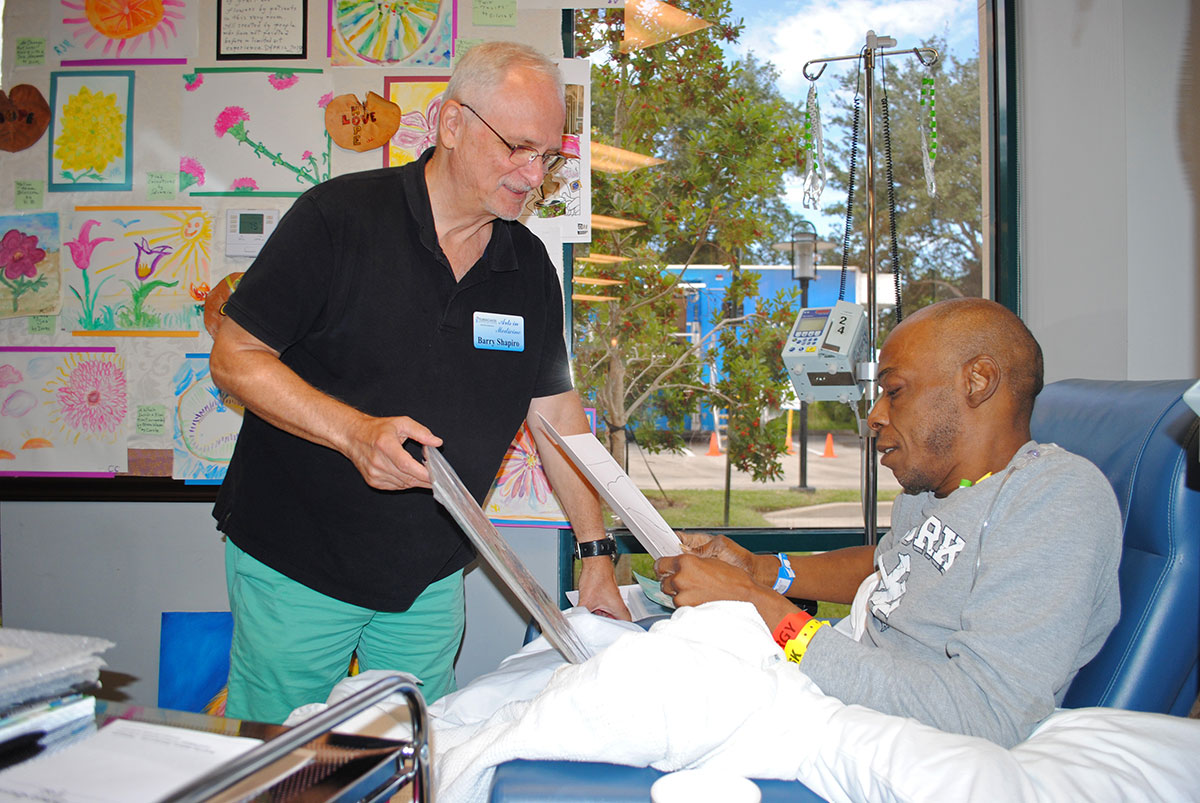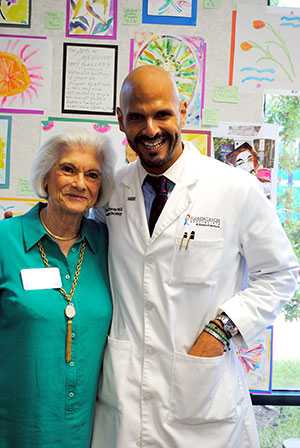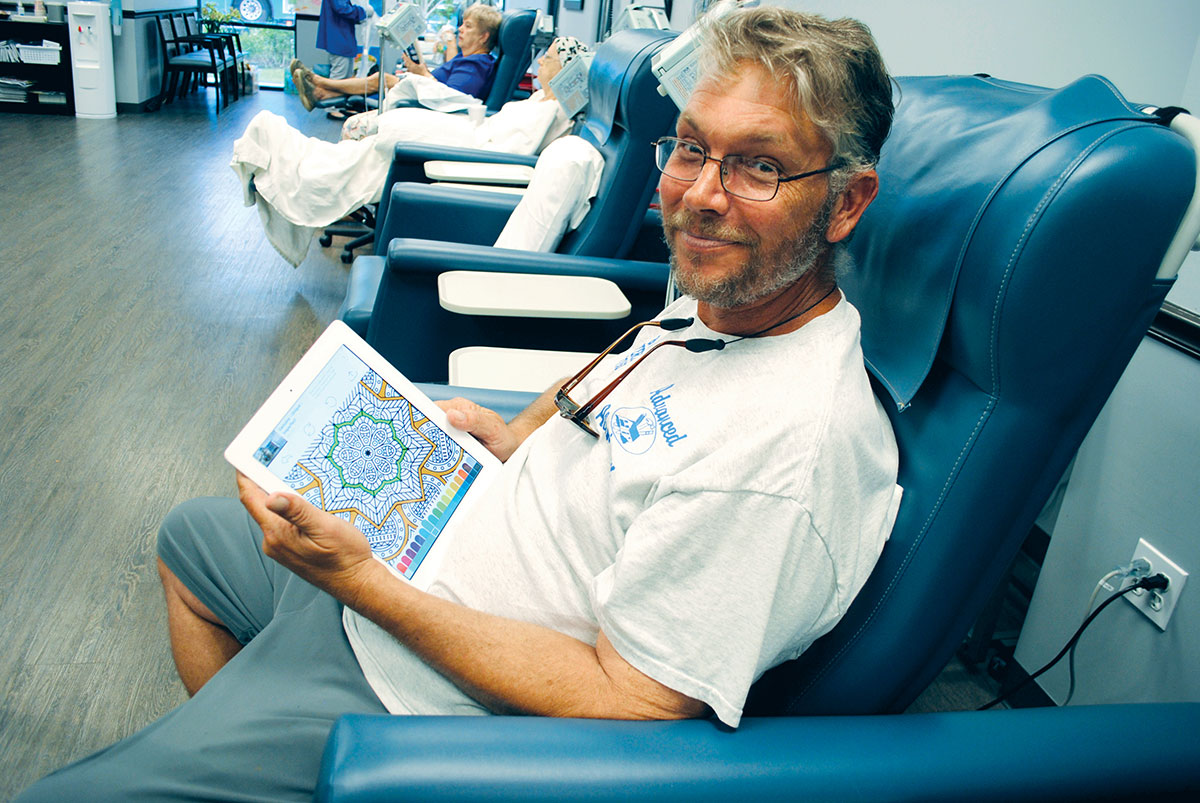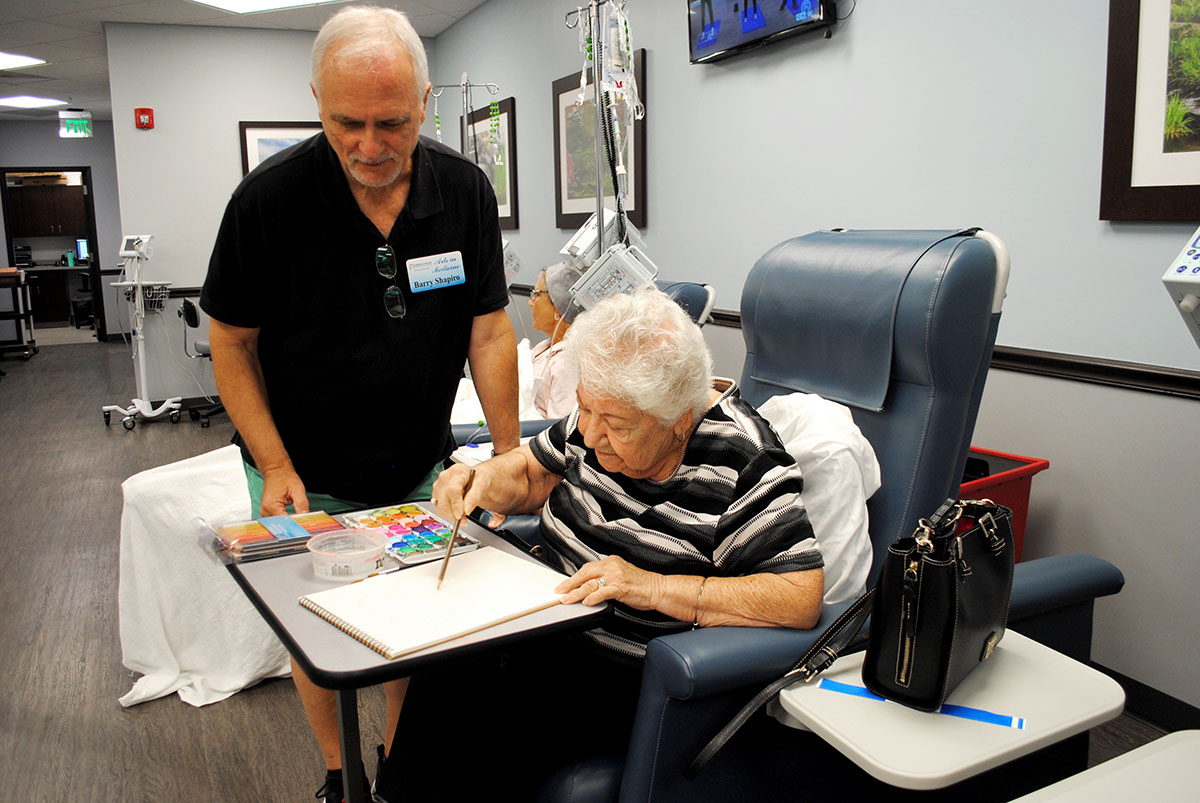Creating a healing environment

Cancer patients gain strength and optimism through art therapy
BY KERRY FIRTH

Cancer. The word alone sends chills up and down the spine. Images of sitting in a room for hours at a time, worrying about the outcome, run through the mind. It’s part of the treatment process, but it doesn’t have to be as miserable as some think. What if one could pass that time by creating a work of art or by listening to some cool jazz? It might just make the treatment a little more tolerable.
The Cultural Council of Indian River County and Florida Cancer Specialists have created a holistic approach to treatment with an innovative Arts in Medicine program in Vero Beach. The program combines arts and artists into a normally sterile and clinical setting. Patients, caregivers and healthcare professionals in the FCS practice are better able to deal with serious illness through this unique method, the first of its kind in the state to use art and medicine in a private practice.
“This is the most exciting thing to happen in my career,” says Dr. Raul Storey, medical oncologist and hematologist. “While it doesn’t change the course of the disease, it absolutely improves their sense of well-being. We treat the patient as a whole, attempting to balance the mind, body and soul. Patients who are entertained during their chemotherapy are less likely to be depressed and more likely to be positive about their diagnosis and prognosis.
“Cancer is no longer a death sentence, and people can live long, productive lives after treatment. Patients gain strength and optimism by participating in activities and interacting with other patients in the same situation. The interaction takes their mind off of the treatment and focuses on the project. Time passes more quickly and their anxiety and depression is lessened. The results have been truly magical.”
Every Tuesday, Wednesday and Thursday from 10 a.m. to 4 p.m., patients are entertained in both the waiting room and the chemo room. Fears are suppressed while they wait for their name to be called by the mellow sounds emitting from a keyboard in the corner of the office. “Some people don’t even realize I’m playing live,” says musician Kenny Clarke. “I see the stress melt off their faces when they sit back and listen. It’s not like piped-in music and I take requests, so it’s really special when they engage. Overall it’s one of the most rewarding gigs I’ve ever done.”

CREATIVE PATIENTS
Inside the chemo room, patients are busy coloring a large Dr. Storey caricature designed by artist Barry Shapiro. “I drew a large outline of their doctor and they choose to finish it in water color, decoupage, pencil or crayons. We have some pretty creative Dr. Storey portraits on the wall. These patients might be here for three or four hours and it helps pass the time.” Also in his art cart are supplies to create paper flowers, mobiles and a couple of iPads loaded with all kinds of artistic programs.
Mind mapping is another favorite project of Shapiro’s. “Basically, a mind map is a way of looking at what’s going on with you at any given time and visualizing how things that are affecting you externally also affect you internally. The object is to have fun as well as look at all those things having an effect on your experience of health issues. Many find this exercise useful in looking at their feelings, emotions, assertions and influences during treatment. By all accounts it breaks up the monotony of treatment.”
“The results are overwhelming,” says Storey. “Chronic inflammation is the source of many diseases, and by reducing the stress and anxiety through art, we promote healing which eventually impacts the course of the disease. We know that integrating art in medicine improves the care experience, increases the sense of well-being and promotes improved recovery. Our goal is to validate the necessary data to expand the program to other offices in Florida and then throughout the United States.”
The program was born of a collaboration between Storey and Barbara Hoffman, executive director at the Cultural Council. Hoffman read about the nationwide Arts in Medicine movement utilizing expressive art in health care settings and contacted the Center for Arts in Medicine at the University of Florida for guidance in setting up the pilot program. She presented the idea to Storey, and he jumped on board. The Vero Beach pilot program completed its six-month trial in September, and the data results will be presented at a UF Arts in Medicine conference in Orlando.
“The response from the artisan community is so positive,” explains Hoffman. “We’ve got musicians, visual artists, performers and actors, storytellers and authors involved. All of them are paid for their time, so it is a real job and they are committed to showing up and doing their best. Most of them have found the experience is more rewarding than the pay.”
Storey notes, “Chronic inflammation is the source of many diseases, and by reducing the stress and anxiety, hopefully, we’ll prove that the healing will change the course of the disease.”

DIFFERENT ACTIVITIES
Patient Antonio Jenkins usually reads a book while he’s getting his chemotherapy but sometimes tries his hand at art on the iPad. “I’m here for six hours a time,” he says. “Having different things to do breaks up the day. I’ll read a while, draw a bit and then try to sleep. It’s not where I want to be, but the different activities certainly make it more tolerable.”
Mary Hoke, an eternally optimistic octogenarian, finds comfort in coloring and making paper flowers. “If I have to be here getting chemo, I might as well have something to do,” she says. “I believe that God put us on earth for a certain amount of time and when that number is up, it’s up. There’s not much we can do about it but enjoy the time we’ve got. If some of my time is spent being hooked up to an intravenous tube, then I’m gonna make the best of it. Singing along with a performer or making something pretty is the best use of that time. I’m so happy these lovely entertainers find time to spend with us.”
Modern medicine has focused on the science of better diagnoses and therapy, but detachment and objectivity may have contributed to isolation and alienation. Arts in Medicine returns to the humanistic origins of medicine, providing patient treatment and compassionate delivery of care. The goal is to create an environment where patients can return to wholeness in their physical, mental, emotional and spiritual life.
“I can’t wait to see this program implemented in private practices around the world,” says Storey. “The transformational power of the arts is undeniable and that is where the inner healing begins.”
